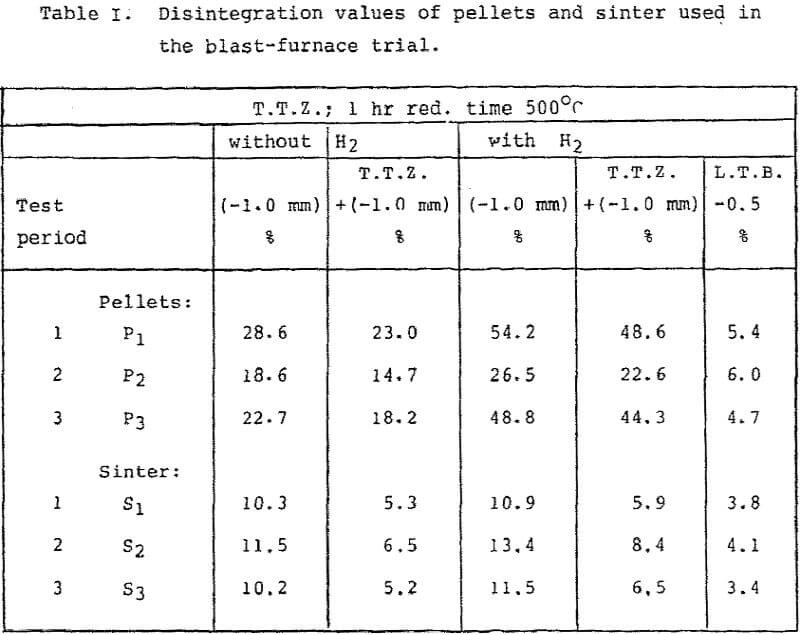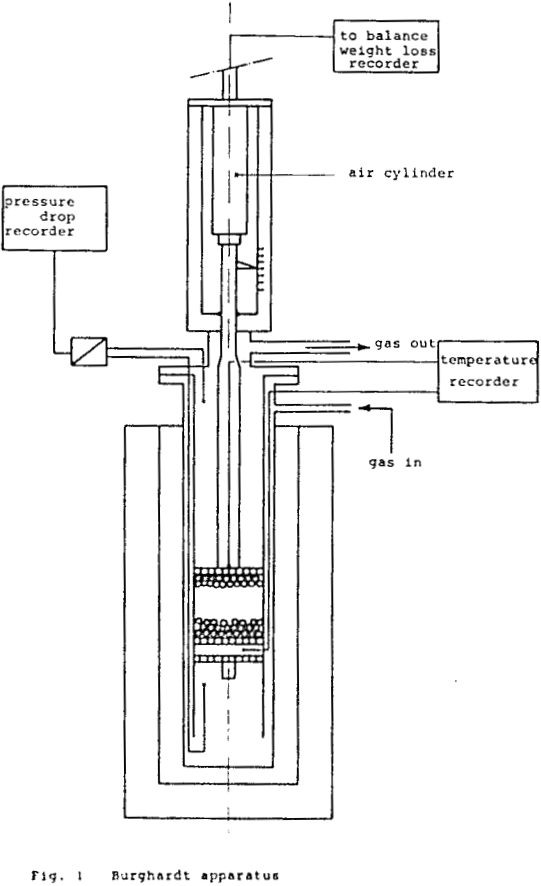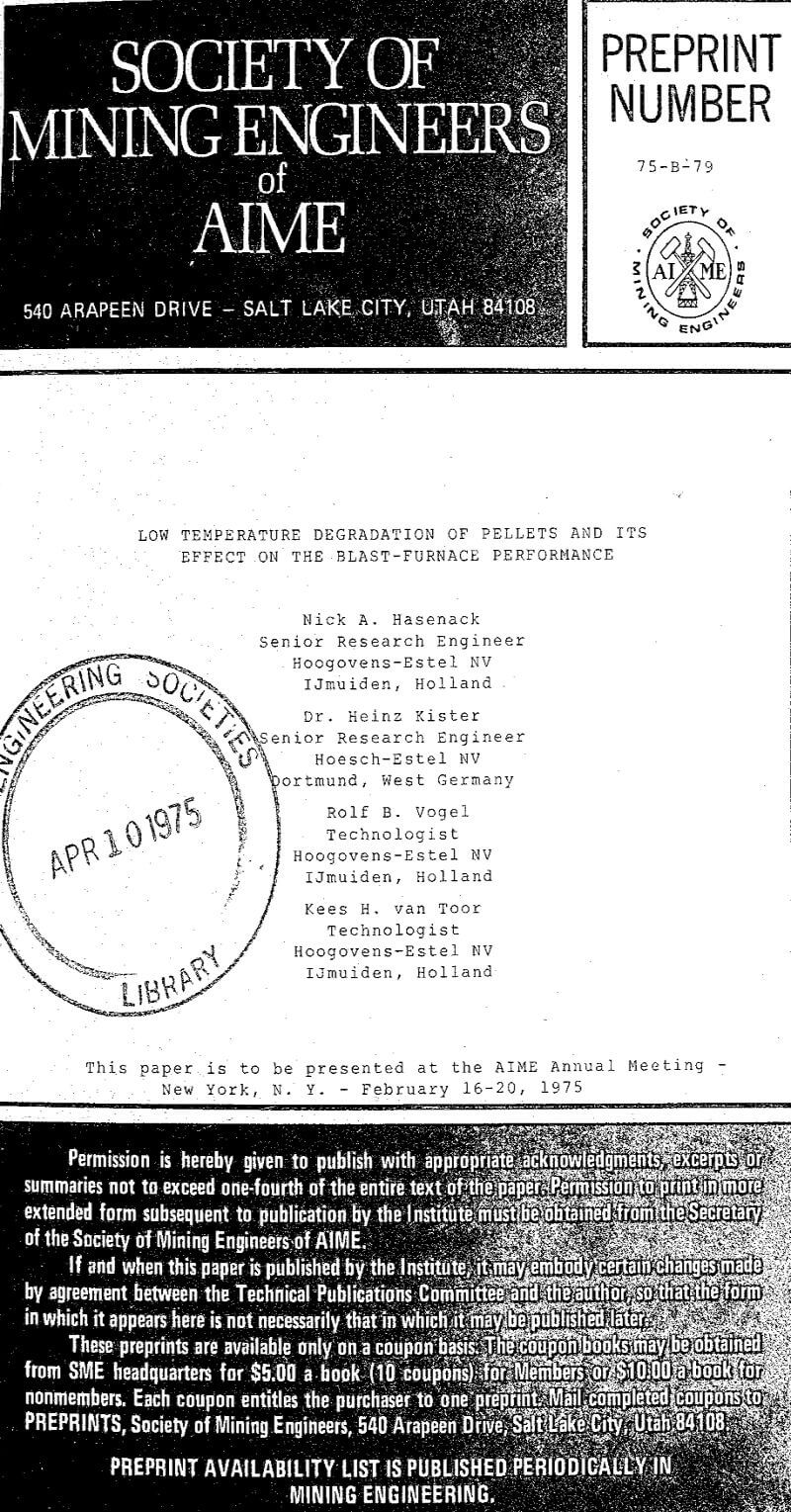Table of Contents
A full survey of the laboratory and blast-furnace tests on 2 types of acid pellets is given. From the laboratory tests out in an atmosphere containing hydrogen, it appears that type B, produced out of 100% magnetitic ores, has a far better low temperature disintegration index and a lower reductibility index than type A, produced from a hematite/magnetite mixture. The swelling index, chemical composition and mechanical properties of both types of pellets do not differ significantly. From the blast-furnace test, carried out with a burden consisting of 45% of pellets and 45% of sinter with basicity ratio about 2.2, and at constant driving rate, it follows that there is no significant relationship between the disintegration value of the pellets and the blast-furnace permeability.
Laboratory Investigations
As H2 attacks the bondings in the pellet more severely than CO, a direct comparison between T.T.Z. and L.T.B. data can only be made by using the same reducing gas in both tests. The correlation between the fractions +6.3 mm produced in the two tests is less pronounced. This is mainly caused by the relatively small difference between the initial and the test size.
It appears that, when no H2 is used, the two test methods lead to the same ranking of the pellets and sinter.
However, as the topgas of an oil injected blast-furnace will always contain 4 to 5% H2 and about an equal amount of H2O, it seems wise to carry out the reduction test with H2 in the reducing gas.
In our case, a gas mixture containing 20% CO; 20% CO2 and 5% H2 is chosen to which 1.15% H2O is added in order to exclude water gas reaction thus maintaining a fixed gas composition in the reduction vessel.
The H2O content is indeed low compared to the H2O content of topgas, but it has been proven, that the test results are independent of the H2O content. The lower H2O concentration could therefore be chosen.
A high basicity ratio and MgO in particular has an improving influence on the disintegration of sinter, caused by the stronger bonding between the original grains. The very low disintegration of the sinter therefore is due to its basicity ratio together with its high MgO content.
The highest disintegration values are found between 400 and 450°C for pellets, whereas the sinter tends to show a maximum between 500 and 550°C. At all temperatures the disintegration of the pellets remains much higher than those of the sinter.
When tested at various times and at the temperature at which maximum disintegration occurs, it appears that, even at short reduction times, the P1 and P3 pellets are far more disintegrated than the P2 pellets (see table 5 and figure 5), indicating an essential difference between resistance against disintegration.
Blast-furnace test
In order to check whether the observed differences in disintegration behaviour of pellets would have any significant influence on blast-furnace performance, a three months’ test has been carried out in blast-furnace no.5 of the Hoogovens IJmuiden plant of Estel.
This furnace was blown in 1961 and had a hearth diameter of 8.5 m. With the relining in 1971 this furnace was enlarged to a hearth diameter of 9.0 m and provided with two tapping holes. The furnace has a working volume of 1493 m³ and 24 tuyeres. The furnace is producing basic iron for the oxygen steel plant.
During the whole test period process parameters as charging sequence, hot blast temperature and volume, slag composition and volume were kept as constant as possible. The blast volume was restricted to maximum of 3000 Nm³/min. by the temporarily shortage of blowers. By doing so, the test periods are characterised by the permeability and not by the rate of production.
Though during the manufacturing of the P1 and P3 pellets the ore mixture underwent many changes, all mixtures were composed according to the formula given in table II and selected for their swelling characteristics, allowing maximum Burghardt indices of 10 mm WG and a free swelling ratio ΔV30.1050 of 23%.
Throughout the whole period the furnace operated smoothly, hangings and slips did not occur. Slag and pig-iron compositions were kept constant. The somewhat higher slag volume (about 16 kg) in the third period is mainly due to an increase of the ash content of the coke, necessitating a correction in the pellet to sinter ratio.
As could be expected when blowing at constant blast volume, the productivity, (expressed in metric tons per sq.m hearth area and per 24 working hours) did not undergo severe changes.
The small mutual differences can be explained completely by the deviation of hot blast volume, driving rate and actual fuel rate.
Due to mechanical problems in the gas cleaning part the top pressure had to be lowered in period 3, but as the permeability of the furnace and the quantity of gas dust remained unchanged, blast-furnace conditions can be considered to be the same as in period 2.



